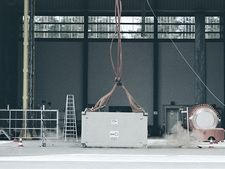Possible accident scenarios
In addition to the safety analysis of normal operation, accident analyses were carried out. The scenarios were based on technical or human failure or rock-mechanical impact. On this basis possible releases of radioactive material were calculated. The hypothetically assumed accidents show that no serious radiological consequences for the population in the vicinity would result.
To determine the accidents, the repository was divided into three areas that were considered separately:
- surface facilities,
- the hoisting system, and
- underground facilities.
Crash, fire and explosion – what happens to the waste package?
Now it was investigated in what way what events could influence the waste package. This could e.g. be a crash of the waste package or a load dropping on the waste package. Another possibility would be transport media loaded with waste packages that could have an accident and be set afire. Also, an internal fire or explosion would be conceivable. The potential radiological consequences for these events were evaluated.
Destruction tests with waste packages

![]() Drop test from a height of up to five metres. The waste package is packed into a closed box and dropped on inflexible ground. The matter released in atomised and aerosol form is collected on filters and measured. Thus it can be determined how much radioactivity could be released from a waste package in the event of a crash
Drop test from a height of up to five metres. The waste package is packed into a closed box and dropped on inflexible ground. The matter released in atomised and aerosol form is collected on filters and measured. Thus it can be determined how much radioactivity could be released from a waste package in the event of a crash
To be able to examine what damage would be caused to the waste packages in the case of one of these events, drop tests were carried out with the containers from different heights. Furthermore, inactive waste packages were burnt for one hour at a temperature of 800 degrees. The released matter was then collected in filters. Thus the size of the released particles could be determined. With the help of these measurements the radioactivity potentially released from a waste package in the event of a fire was calculated and the maximum possible radiological consequences were calculated.
Scenario: Air crash
Additionally, the possible radiological consequences of an assumed air crash onto the Konrad 2 surface facilities were investigated. In a supplementary investigation conducted by the experts of the Lower Saxon Ministry for the Environment, Energy and Climate Protection (NMU), the possible radiological consequences of a crash of a fully fuelled large four-engine aircraft were considered, too.
Result: No impermissible radiological consequences for the population
The calculated radiation exposures show that the hypothetically assumed accidents would not result in serious radiological consequences for the population in the vicinity. In none of the scenarios would the accident planning levels set out in the Radiation Protection Ordinance (50 millisieverts effective dose) be exceeded. The self-restriction to maximum 20 millisierverts effective dose applied by the BfS would also be complied with.
State of 2016.04.01

